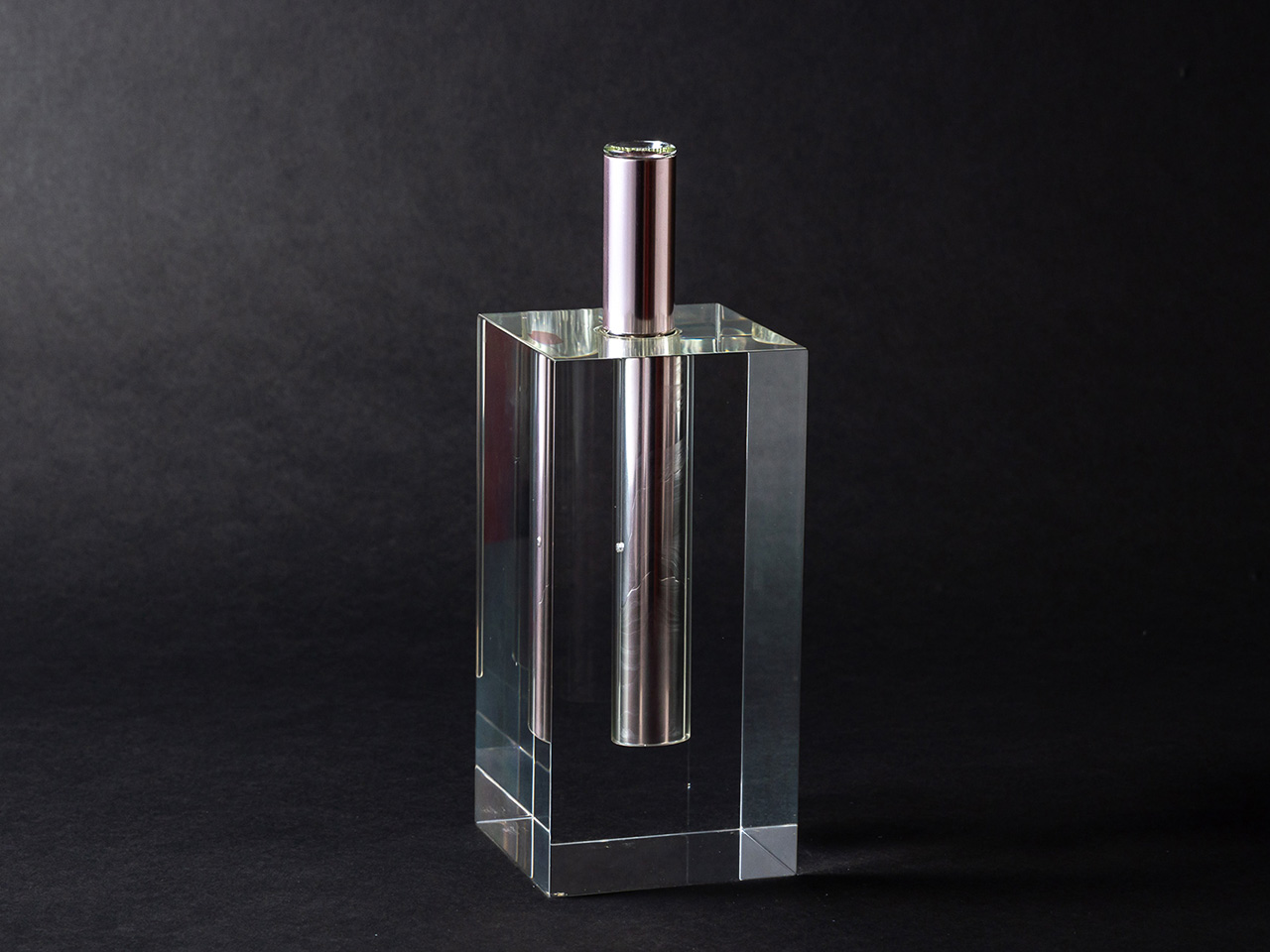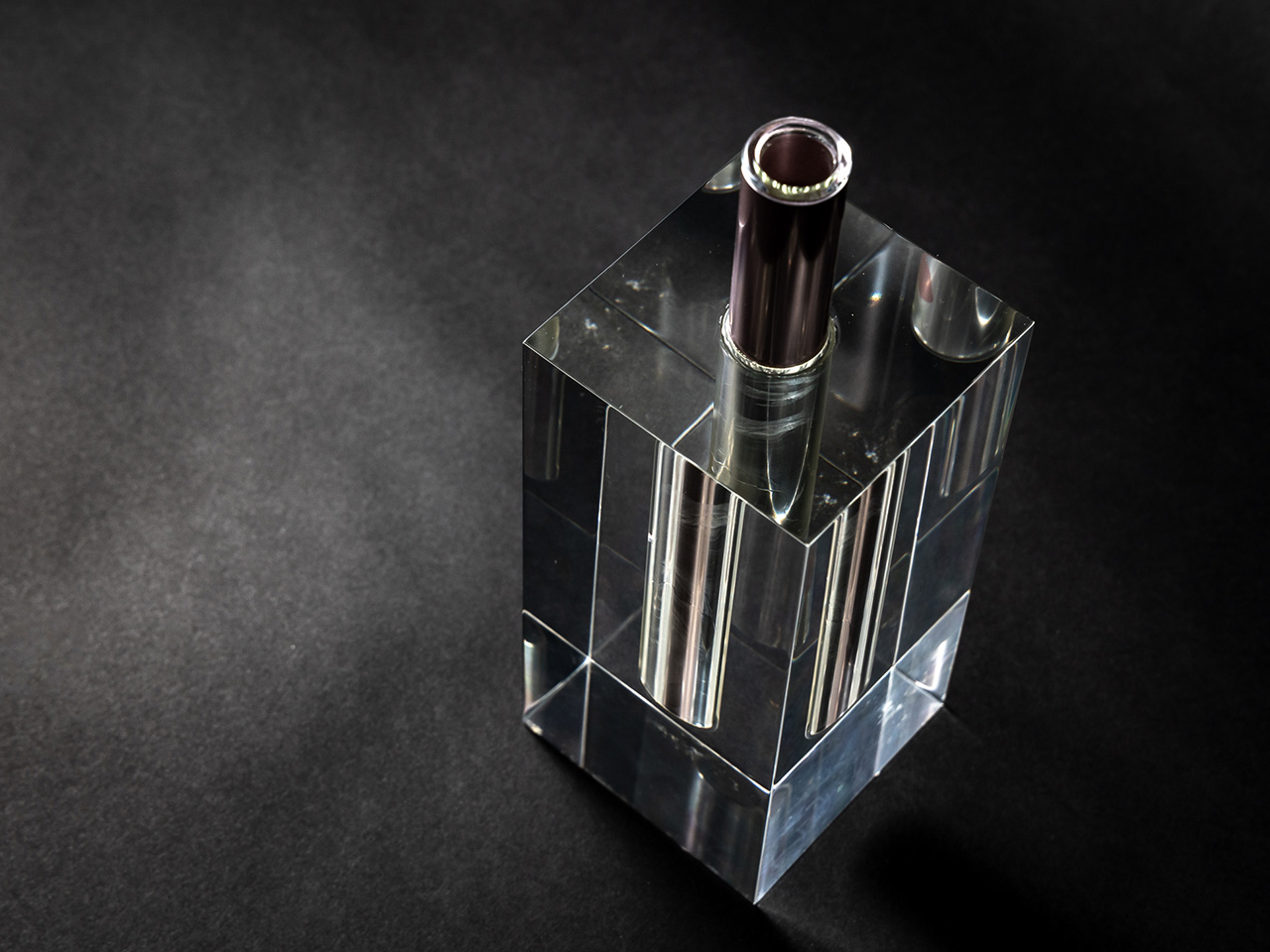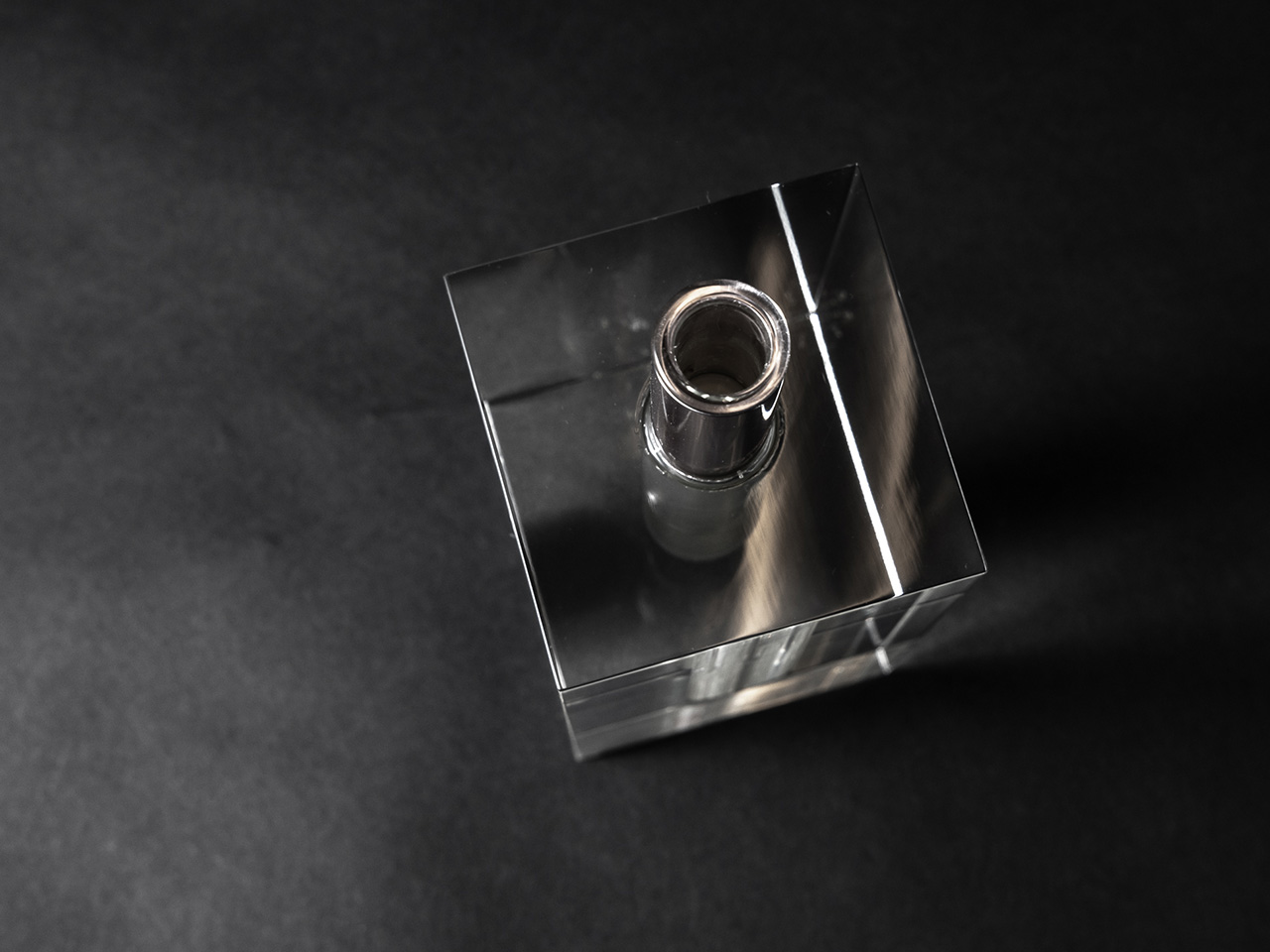倉俣 史朗/Kuramata Shiro
倉俣史朗(1934~1991)は、透明感や浮遊感に満ちた空間や家具のデザインを生み出し、日本の現代デザインに一時代を築いたインテリアデザイナーです。
倉俣の父が東京本郷の理化学研究所の副主事を務めていた関係で、彼が生まれたのは研究所の社宅でした。この研究所の洋風建築が、倉俣にとっての原風景のひとつだったと言われています。また、幼い頃から漫画の模写や工作を得意とし、小学生のときには大工の棟梁の仕事場に遊びに行った際、建築の「青写真」に惹かれて建築家に憧れるなど、幼少期からものづくりに関心を寄せていたことが窺えます。東京都立工芸高等学校木材科を卒業後、1954年に帝国器材家具工場に就職しますが、柳宗理(1915~2011)がデザインしたレコードプレーヤーや山口文象(1902~1978)が手がけたイスに触発された倉俣は、この翌年に桑沢デザイン研究所リビングデザイン科に入学し、本格的にデザイナーを志します。ここでデザインの基礎を学んだほか、青山の小原会館(現在は小原流会館)で開催された「具体美術展」にも足を運び、衝撃を受けたといいます。同研究所を卒業後は、株式会社三愛宣伝課に入社し、店舗設計やショーケースのデザイン、ウィンドウディスプレイといった業務に携わるようになります。
上記のように研鑽を積んだのち、1965年に独立してクラマタデザイン事務所を構え、以降は自身の美意識や感性に基づく独自のデザインを手がけていきます。倉俣の仕事は主に、三宅一生のブティックに代表される店舗や展覧会などの空間デザインと、商品化や使用を前提としないオブジェ的な家具や小物のデザインの二つに分けられますが、いずれの制作においても、「重力からの解放」や「光による構造体」といった主題は通底しています。たとえば、【光のテーブル】(1969年)という作品では、5ミリの乳白色のプラスチック板を組み立てて作ったテーブルのなかに蛍光灯をしこんでいますが、本来素材になりえない光を主役とするこの手法は、商業施設の壁や柱、梁にも採用されています。
倉俣のデザインとしてよく知られているのは、テラゾー(人工大理石)に色ガラスの破片を散りばめた「スターピース」シリーズや、板ガラスを強力なボンドで貼り合わせたきわめてシンプルな「ガラスのイス」、【ハウ・ハイ・ザ・ムーン】(1986年)に代表される、金属材料に切れ目を入れて引き伸ばし、網目状にしたエキスパンドメタル製の作品など、枚挙にいとまがありません。中でもとりわけ有名であり、倉俣が追求してきた造形美の集大成とも言えるのが、「ミス・ブランチ」シリーズです。戯曲『欲望という名の電車』(1947年)の主人公の名を持ち、造花のバラを透明アクリル樹脂に封じこめたこのイスは、一瞬で失われてしまうはずの美を永遠に内包し、鑑賞者をあらゆる因習や常識から解き放ちます。1980年代後半からは着色されたアクリルが使われるようになり、その鮮やかな色彩が、より一層夢見心地の浮遊感を生み出しています。
倉俣が師として仰ぐイタリアデザイン界の巨匠、エットレ・ソットサス(1917~2007)とは1981年に出会い、彼の誘いでデザイン運動「メンフィス」に参加して以降、倉俣の名や作品は世界中に浸透しました。その後、フランス文化省芸術文化勲章を受章するなど、国際的にも高い評価を受けた倉俣は、1991年に心不全で急逝します。しかし、彼の詩情に満ちたデザインや研ぎ澄まされた感性は作品のなかで今なお息づき、国内のみならず、海外のクリエイターたちにも影響を与え続けています。
Shiro Kuramata (1934-1991) was an interior designer who created spaces and furniture designs characterized by transparency and a sense of floating, establishing an era in Japanese contemporary design.
Kuramata was born in the staff housing of the RIKEN (Institute of Physical and Chemical Research) in Hongo, Tokyo, where his father served as an assistant director. The Western-style architecture of this institute is said to have left a lasting impression on Kuramata. From a young age, he excelled at copying manga and crafting, and during elementary school, he was fascinated by architectural blueprints when he visited the workshop of a master carpenter, nurturing his creative interest from childhood. After graduating from the Woodcraft Department of Tokyo Metropolitan Kogei High School, he joined the Teikoku Kizai Furniture Factory in 1954. Inspired by designs like Sori Yanagi (1915-2011)’s record player and Bunzo Yamaguchi (1902-1978)’s chairs, Kuramata enrolled in the Living Design Department of Kuwasawa Design School the following year, aspiring to become a professional designer. Here, he learned the fundamentals of design and was deeply moved by the “Gutai Art Exhibition” held at the Ohara Hall (now Ohara Ryu Hall) in Aoyama. After graduating from there, he joined the public relations department of San-ai Co., Ltd., engaging in store design, showcase design, and window displays.
After refining his skills, Kuramata established his own office, Kuramata Design Office, in 1965, and began creating unique designs based on his own aesthetic sense and sensitivity. His work primarily fell into two categories: spatial design for stores and exhibitions, represented by Issey Miyake boutiques, and sculptural furniture and small objects not intended for commercialization or practical use. In both areas, themes such as “Liberation from Gravity” and “Structures Created by Light” were evident. For instance, in his work “Table of Light” (1969), he assembled a table from 5mm thick milky white plastic panels with fluorescent lights embedded inside. This approach, where light, an inherently intangible material, became the main feature, was also applied to the walls, columns, and beams of commercial facilities.
Kuramata’s designs include the “Star Piece” series, which scattered colored glass fragments in terrazzo (a type of artificial marble), the extremely simple “Glass Chair” made by bonding glass panels with strong adhesive, and works made of expanded metal, such as “How High the Moon” (1986), where metal materials were cut and stretched into a mesh. There are countless other examples of his innovative work. Among these, the most famous and considered the culmination of Kuramata’s pursuit of aesthetic beauty is the “Miss Blanche” series. Named after the protagonist of the play “A Streetcar Named Desire” (1947), this chair encapsulated artificial roses in transparent acrylic resin, eternally preserving beauty that would otherwise be ephemeral, and freeing the viewer from all conventions and common sense. From the late 1980s, colored acrylic was used, enhancing the dreamlike sense of floating with its vivid colors.
Kuramata met Ettore Sottsass (1917-2007), a master of Italian design whom he revered as a mentor, in 1981 and, at Sottsass’s invitation, joined the design movement “Memphis”. Since then, Kuramata’s name and works have gained global recognition. He received numerous international accolades, including the Ordre des Arts et des Lettres from the French Ministry of Culture. Kuramata passed away suddenly from heart failure in 1991, but his poetic designs and refined sensitivity continue to live on in his works, influencing creators not only in Japan but also abroad.




作品名:Flower Vase #1301 pink (Early)
サイズ:H22×W8×D8cm
価格:300,000円
価格は税抜き表示です

